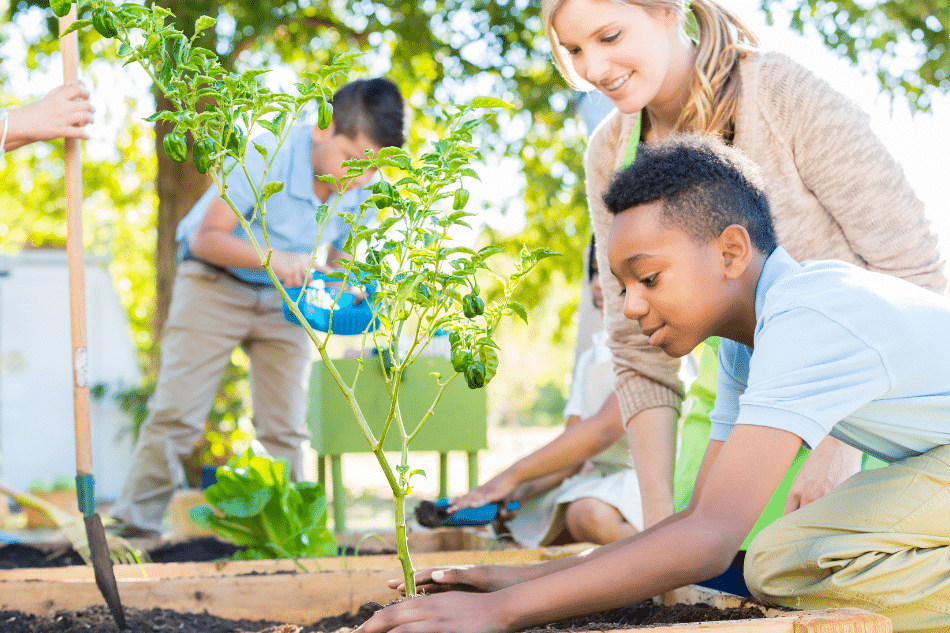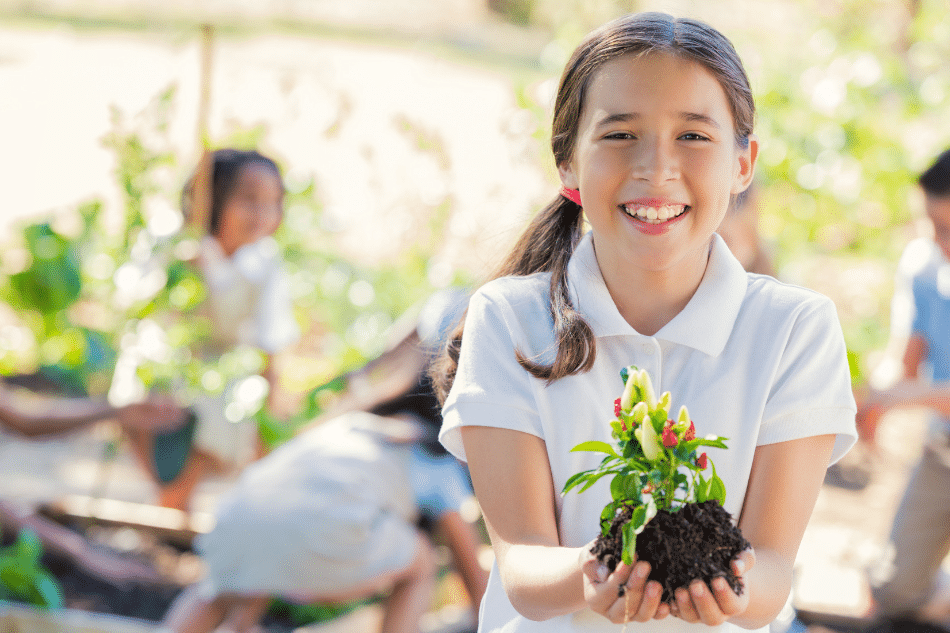Healing in the Community: Group Gardening Therapy Activities for Teens

For many teens, healing doesn’t always begin with words; instead, it starts with soil. Group gardening therapy activities provide a quiet but powerful path toward emotional growth, using the rhythms of nature and the structure of shared tasks to build trust, stability, and self-worth.
What makes gardening especially impactful is how it supports nervous system regulation without requiring direct emotional confrontation. The body begins to relax in predictable routines like digging, planting, and watering. Such activities stimulate sensory pathways that gently draw teens into the present moment and reduce internal overwhelm.
Additionally, research shows that group therapy in garden settings can reduce stress, ease symptoms of depression and anxiety, and support social development.¹ These peer gardening mental health benefits can be especially meaningful for teens who struggle to connect in traditional talk therapy settings. Social horticultural therapy gives them something to nurture and share. In the right environment, even small cooperative gardening moments like watering together or planting side by side can support deep internal shifts.
If you’re curious about the benefits of group gardening activities for teen mental health, this page walks you through the process, step by step, including:
- The mental health benefits of peer gardening
- Mental health issues that can be treated with social horticultural therapy
- Group gardening therapy activities
- What to expect in group plant-based wellness sessions
- How Mission Prep can help with youth outdoor therapy programs

Peer Gardening Mental Health Benefits
Teens thrive when they feel connected, both to others and to something meaningful. This is where the power of peer gardening comes in. Sessions offer a quiet kind of connection. No one has to open up right away or explain how they feel. Instead, teens join in by planting, watering, and working side by side. It’s social, but without pressure.
Gardening also triggers changes in brain chemistry.² For example, touching soil boosts serotonin, while repeated, rhythmic movement helps regulate dopamine.³ Additionally, being outside lowers cortisol, easing stress and promoting calm.⁴
For teens who are anxious, withdrawn, or unsure how to connect, gardening in a shared space offers a gentle entry point. They contribute something real, see it grow, and begin to build trust – not just with others, but with themselves.
Further, research shows that social horticultural therapy can improve emotional regulation, increase self-awareness, and strengthen interpersonal skills.⁵ These benefits come from:
- Practicing turn-taking and patience
- Respecting personal and emotional boundaries
- Experiencing shared accomplishment
- Learning to care for something together
- Building communication skills through small, consistent actions
- Developing a rhythm with peers without needing constant conversation
- Gaining confidence in social settings
- Feeling a renewed sense of belonging
Teen Mental Health Issues Treated with Social Horticultural Therapy
Each young person may respond to traditional therapy differently. While some might find it relatively easy to open up in a therapist’s office, others may struggle to communicate what they’re feeling. Social horticultural therapy offers something different from the norm. By working together in garden spaces, teens can access emotional healing through movement, structure, and connection, all without the formality of a clinical setting.
Group gardening therapy activities support teens with:
- Anxiety and social withdrawal: Therapeutic gardening is shown to promote social skills and develop confidence.⁶ It allows teens who struggle with anxious thoughts or discomfort in groups to ease into shared experiences at their own pace.
- Depression: A garden offers visible signs of growth and change. For teens with low mood, team garden projects for youth can help restore a sense of purpose while reducing depressive symptoms.⁷
- Emotional dysregulation: Tending to plants helps teens practice emotional pacing, patience, attention, and care. These are skills that support regulation both in and outside of therapy.⁸
- Trauma and grief: Research shows that gardening can help people overcome fear, anger, and sadness.⁹ This is because therapeutic group outdoor sessions create a sensory-rich, grounding environment, allowing teens to connect with the earth and each other without needing to speak about trauma directly.
- Low self-esteem: Studies show that even a single session of allotment gardening can boost self-esteem and mood.¹⁰ In many ways, each successful seedling becomes a reminder to teens that what they’re doing matters.
Additionally, because gardening activates multiple senses (touch, smell, sight, and sound), it supports nervous system regulation. Plus, when teens work together, they begin to experience youth bonding through horticulture, showing them that connection can be consistent and pressure-free.
Group Gardening Therapy Activities
Not all group gardening sessions are the same. Therapists usually have specific activities that they focus on, but each is carried out with flexibility. During a typical group gardening session, the focus shifts from “talking about feelings” to shared movement, co-creation, and steady connection.
Also, sessions aren’t just about planting. Interactive gardening for teens involves a variety of supportive, structured tasks that still leave room for spontaneity and fun. For example, common activities used in therapeutic group sessions include:
- Creating raised beds or planter boxes: A physical, team-based project that allows teens to collaborate on something meaningful from the ground up
- Seed selection and planting rotations: Encouraging decision-making, patience, and responsibility across the group
- Composting stations: Turning waste into nourishment, which is symbolic of personal growth and recovery
- Herb and sensory gardens: Tapping into calming scents and textures, offering a subtle way to support sensory regulation and mindfulness
- Watering schedules and rotating roles: Helping teens build predictability and reliability within a peer setting
Once tasks are complete, teens may be asked to journal, reflect, or find some way to connect with how they’re feeling.
The best team garden projects for youth aren’t necessarily complex, but they’re consistent. They give teens a reason to show up, contribute, and be seen. Over time, small successes – like seeing a sprout emerge – open the door to bigger emotional shifts.
Plus, because activities are shared, teens begin to feel part of something bigger and more inclusive than the struggles they’re experiencing.
What to Expect in Group Plant-Based Wellness Sessions
How a group gardening session plays out depends on the group and the therapist. In group plant-based wellness sessions, the garden becomes the therapist’s office, removing the focus from talking about difficulties.
Sessions typically begin with grounding practices of noticing sensations, naming the weather, or quietly observing what’s growing. For many teens, this feels more approachable than being asked to share emotions out loud.
Over time, the structure of group therapy in garden settings begins to feel both safe and familiar. Teens might water herbs side by side, repot seedlings, or harvest vegetables. These shared rituals support co-regulation, allowing nervous systems to settle
Group gardening activities may include:
- Light structure with lots of flexibility
- Time spent outdoors, often with sensory elements woven in
- Projects that build from week to week, giving teens a sense of ownership
- Space to reflect, sometimes silently, and other times through guided conversation
While the format of sessions may vary, the goal of group gardening therapy activities stays the same: to help teens re-engage socially, emotionally, and physically.
The best youth outdoor therapy programs know that healing sometimes looks like digging side by side, laughing over mistakes, and watching growth.

Reach Out to Mission Prep for More Info On Youth Outdoor Therapy Programs
At Mission Prep, we understand the unique challenges that come with adolescence, especially for teens navigating anxiety, trauma, or emotional isolation. We also recognize that, while every teen deserves access to healing spaces, not every family has the resources to create these spaces alone.
Our youth outdoor therapy programs are designed to meet teens where they are, combining structure, support, and nature-based healing. Whether your teen could benefit from group gardening therapy activities or simply needs a safe place to reconnect with themselves and others, we’re here to help guide the way.
Reach out to our team today if you’d like to learn more about our treatment programs, or simply to find out how a garden can become more than just soil and plants.
References
- Wood, C. J., Barton, J., & Wicks, C. L. (2024). Effectiveness of social and therapeutic horticulture for reducing symptoms of depression and anxiety: A systematic review and meta-analysis. Frontiers in Psychiatry, 15, 1507354. https://www.frontiersin.org/journals/psychiatry/articles/10.3389/fpsyt.2024.1507354/full
- Kim, S.-O., Kim, M. J., Choi, N.-Y., Kim, J. H., Oh, M. S., Lee, C. H., & Park, S.-A. (2022). Psychophysiological and metabolomics responses of adults during horticultural activities using soil inoculated with Streptomyces rimosus: A pilot study. International Journal of Environmental Research and Public Health, 19(19), 12901. https://pmc.ncbi.nlm.nih.gov/articles/PMC9564959/
- Marques, A., Marconcin, P., Werneck, A. O., Ferrari, G., Gouveia, É. R., Kliegel, M., Peralta, M., & Ihle, A. (2021). Bidirectional association between physical activity and dopamine across adulthood: A systematic review. Brain Sciences, 11(7), 829. https://pmc.ncbi.nlm.nih.gov/articles/PMC8301978/
- Jones, R., Tarter, R., & Ross, A. M. (2021). Greenspace interventions, stress and cortisol: A scoping review. International Journal of Environmental Research and Public Health, 18(6), 2802. https://pmc.ncbi.nlm.nih.gov/articles/PMC8001092/
- Zhou, C., & Zeng, C. (2023). The role of horticultural therapy in promoting physical and mental health. Research in Health Science, 8(3), 43. https://www.researchgate.net/publication/373479638_The_Role_of_Horticultural_Therapy_in_Promoting_Physical_and_Mental_Health/fulltext/64edfc44e081b872fd07e52f/The-Role-of-Horticultural-Therapy-in-Promoting-Physical-and-Mental-Health.pdf
- Wood, C. J., Polley, M., Barton, J. L., & Wicks, C. L. (2022). Therapeutic community gardening as a green social prescription for mental ill-health: Impact, barriers, and facilitators from the perspective of multiple stakeholders. International Journal of Environmental Research and Public Health, 19(20), 13612. https://pmc.ncbi.nlm.nih.gov/articles/PMC9603302/
- van Lier, L. E., Utter, J., Denny, S., Lucassen, M., Dyson, B., & Clark, T. (2016). Home gardening and the health and well-being of adolescents. Health Promotion Practice, 18(1), 34–43. https://pubmed.ncbi.nlm.nih.gov/27765876/
- Oh, Y.-A., Lee, A.-Y., An, K. J., & Park, S.-A. (2020). Horticultural therapy program for improving emotional well-being of elementary school students: An observational study. Integrative Medicine Research, 9(1), 37–41. https://www.sciencedirect.com/science/article/pii/S221342202030007X
- Thompson, R. (2018). Gardening for health: A regular dose of gardening. Clinical Medicine, 18(3), 201–205. https://pmc.ncbi.nlm.nih.gov/articles/PMC6334070/
- Wood, C. J., Pretty, J., & Griffin, M. (2016). A case–control study of the health and well-being benefits of allotment gardening. Journal of Public Health, 38(3), e336–e344. https://academic.oup.com/jpubhealth/article-abstract/38/3/e336/2239844?redirectedFrom=fulltext













